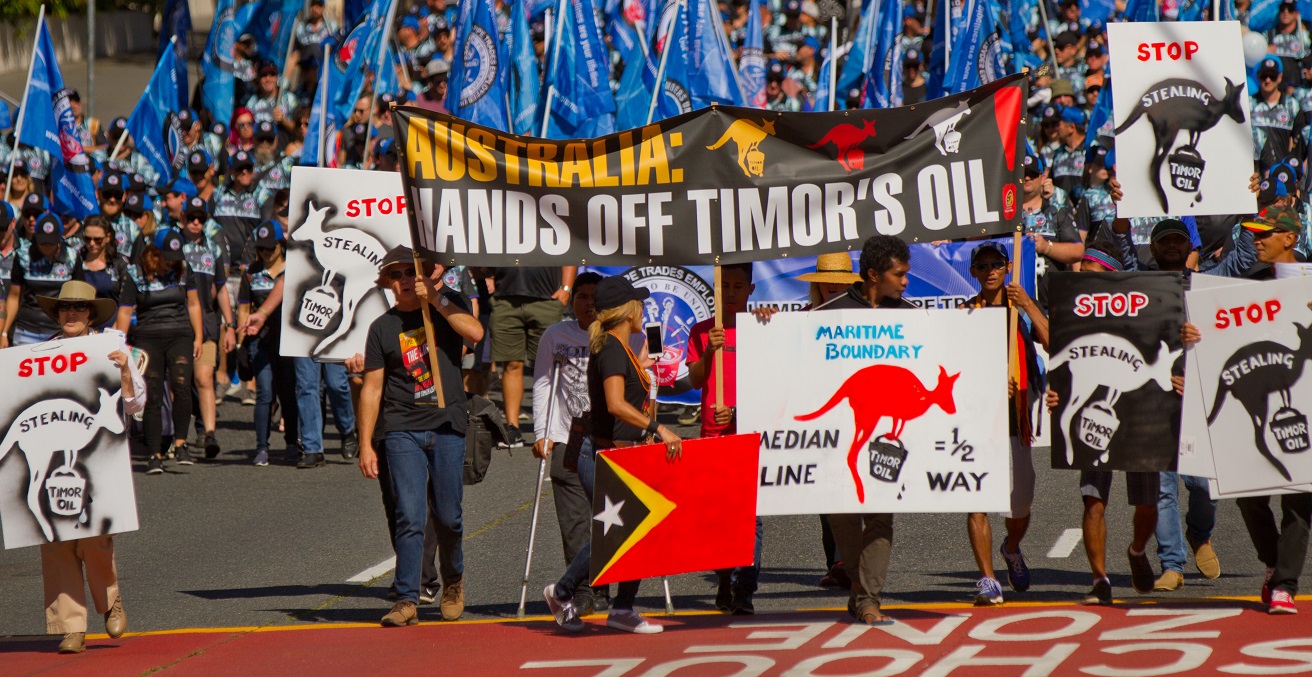Law of the Sea: Settling the Australia and Timor-Leste Dispute

Earlier this month, the long-running and often bitter dispute between Timor-Leste and Australia over maritime boundaries and resources in the Timor Sea was finally resolved.
In April 2015, Timor-Leste initiated United Nations Compulsory Conciliation (UNCC) proceedings under Annex V of United Nations Convention on the Law of the Sea (UNCLOS) in an effort to advance its interests.
The UNCC proceedings were scheduled to run for one year, and the meetings in Copenhagen, Singapore and elsewhere remain confidential. However, at various stages, the parties revealed a number of agreements had been reached.
Early in 2017, both states agreed to terminate the 2006 Treaty on Certain Maritime Arrangements in the Timor Sea (CMATS), a controversial treaty that was designed to distribute revenues derived from the lucrative but disputed Greater Sunrise field. This was followed by news that Timor-Leste would drop two international legal proceedings against Australia.
Following this, in early September a press release was issued offering vague details of an agreement package, wherein both states had agreed to the central elements of a maritime boundary delimitation. This agreement also “addresses the legal status of the Greater Sunrise gas field, the establishment of a Special Regime for Greater Sunrise, a pathway to the development of the resource, and the sharing of the resulting revenue.”
A victory for Timor-Leste?
The commentary on the agreement has been mixed. While some supporters are celebrating—believing the deal has vindicated Timor-Leste’s risky foreign policy approach—others see this as “another chapter in Australia bullying its tiny near neighbour into acquiescing to a deal that is less than to which East Timor believed it was entitled.”
The well-regarded Timor-Leste-based civil society organisation La’o Hamutuk sensibly exercises caution, believing it is too early to consider this a victory for Timor-Leste’s sovereignty and warning that this agreement may in fact constitute a CMATS redux. Advocates such as La’o Hamutuk were critical of CMATS because they perceived the moratorium it placed on permanent maritime boundary delimitation as denying Timor-Leste’s rights to boundaries. They warn that in 2005 CMATS was also considered a victory for Timor-Leste.
Based on what has been publicly released, this agreement appears to be a positive sign for bilateral relations. Unlike CMATS, where boundary delimitation was put on hold for 50 years, in the Copenhagen agreement, the states have used a combination of maritime boundary delimitation and a joint development zone to resolve the dispute. This has meant that both states have ultimately had to compromise on their positions.
Symbolic versus material interests
What this deal means for Timor-Leste depends on the foreign policy goal that is being emphasised. In brokering the CMATS, Australia and Timor-Leste set aside some intractable disagreements regarding Timor-Leste’s desire to establish permanent maritime boundaries, as well as how the field would be developed.
After signing the treaty, Timor-Leste’s representatives sought to win the right to build a pipeline. Australia and its venture partners refused and negotiations stalled. The pipeline was a central element of the ambitious development agenda of successive Timorese governments. Timor-Leste’s 2011 Strategic Development Plan committed Timor-Leste to developing its oil refinery industries. The centrepiece was the Tasi Mane project on the south coast which was criticised by observers as a fantasy and a white elephant.
Timor-Leste reinvigorated pursuit of permanent boundaries after its arguments for a pipeline had failed and reoriented their foreign policy to say that delimitation was the only acceptable solution to the dispute. By initiating UNCC processes and withdrawing from CMATS, Timor-Leste abandoned the pipeline negotiations with Australia for the pursuit of a greater prize: permanent maritime boundaries with ownership of Greater Sunrise.
Yet Timor-Leste’s national interests were presented by leaders as symbolic rather than material, the key interest was in completing sovereignty rather than pursuing oil revenues. Prime Minister Rui Maria de Araujo, for instance, argued that “establishing permanent boundaries is a matter of national priority for Timor-Leste as the final step in realising our sovereignty as an independent state.” Timorese representatives linked the Timor Sea dispute with its struggle for independence against Indonesian occupation.
The concept of maritime boundaries is relatively new in international relations. In the pre-UNCLOS era, international law of the sea was largely governed by Grotian principles of the open seas, whereby the sea was not considered akin to land for the purposes of delineating sovereign jurisdictions. Rather, the sea was considered a global commons beyond the three nautical miles of territorial seas that states could claim under the cannon-shot rule.
UNCLOS introduced a layered sovereignty regime that provided new incentives for states to extend their sovereignty seawards, generating new disputes over overlapping jurisdictions and radically transforming and complicating boundary negotiations and entitlements. Within international legal cases, there have been disputes over whether the two domains of land and maritime space are comparable. In 1986, one judge argued that the differences between the two are “manifest and irreducible”, and that the concept of sovereignty (and its resultant rights to territorial integrity) are not relevant to maritime spaces.
In essence, the claim that sovereignty or independence is incomplete without maritime boundaries is problematic, particularly given the hundreds of maritime boundaries that remain unresolved across the world.
What we know (and don’t know)
For the majority of the maritime area under question—the Joint Petroleum Development Area (JPDA)—the maritime boundary means little in material terms, unless there are untapped hydrocarbon resources that have not yet been found. The 2002 Timor Sea Treaty that governs the JPDA mandated a 90:10 revenue split in Timor-Leste’s favour, while Australia received rights to pipe the oil to Darwin for processing.
The central concern, then, was about the development of the Greater Sunrise gas field. On this issue, Timor-Leste appears to have conceded full ownership of the field. We know this because the states have reached an agreement on a shared development plan. What we don’t know is what this plan means for Timor-Leste’s ambitious development agenda.
We also don’t know what elements for delimitation have been negotiated, but it seems likely that the agreement would conform to median line principles under UNCLOS.
However, the real question is whether the states have reached an agreement on whether simple or adjusted equidistance principles are used for deciding the eastern lateral boundary. If Timor-Leste agrees that simple equidistance should be used to determine the eastern lateral boundary—as argued by Australia—then around 80 per cent of the field would fall into Australia’s territory.
This scenario would mean that Timor-Leste has sacrificed ownership of the field for a maritime boundary and, perhaps, a better deal in developing the field.
A win for UNCLOS?
In 2002, Australia excluded itself from the compulsory jurisdiction of UNCLOS on maritime boundary disputes, meaning Timor-Leste could not take Australia to an international court or tribunal on delimitation matters.
The Timor Sea dispute was a test case for the UNCC proceedings as a non-binding, mediated method of dispute resolution. An agreement between Australia and Timor-Leste formed from bilateral negotiations under the auspices of UNCLOS may then offer broader lessons to the region on maritime dispute management. We will know more in October when the agreement is expected to be finalised.
Dr Rebecca Strating is a lecturer in politics at La Trobe University. Her research focuses primarily on Indonesia and Timor-Leste.
This article is published under a Creative Commons Licence and may be republished with attribution.





